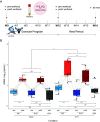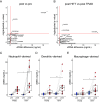Exercise intensity and training alter the innate immune cell type and chromosomal origins of circulating cell-free DNA in humans
- PMID: 39805013
- PMCID: PMC11761974
- DOI: 10.1073/pnas.2406954122
Exercise intensity and training alter the innate immune cell type and chromosomal origins of circulating cell-free DNA in humans
Abstract
Exercising regularly promotes health, but these benefits are complicated by acute inflammation induced by exercise. A potential source of inflammation is cell-free DNA (cfDNA), yet the cellular origins, molecular causes, and immune system interactions of exercise-induced cfDNA are unclear. To study these, 10 healthy individuals were randomized to a 12-wk exercise program of either high-intensity tactical training (HITT) or traditional moderate-intensity training (TRAD). Blood plasma was collected pre- and postexercise at weeks 0 and 12 and after 4 wk of detraining upon program completion. Whole-genome enzymatic methylation sequencing (EM-seq) with cell-type proportion deconvolution was applied to cfDNA obtained from the 50 plasma samples and paired to concentration measurements for 90 circulating cytokines. Acute exercise increased the release of cfDNA from neutrophils, dendritic cells (DCs), and macrophages proportional to exercise intensity. Exercise training reduced cfDNA released in HITT participants but not TRAD and from DCs and macrophages but not neutrophils. For most participants, training lowered mitochondrial cfDNA at rest, even after detraining. Using a sequencing analysis approach we developed, we concluded that rapid ETosis, a process of cell death where cells release DNA extracellular traps, was the likely source of cfDNA, demonstrated by enrichment of nuclear DNA. Further, several cytokines were induced by acute exercise, such as IL-6, IL-10, and IL-16, and training attenuated the induction of only IL-6 and IL-17F. Cytokine levels were not associated with cfDNA induction, suggesting that these cytokines are not the main cause of exercise-induced cfDNA. Overall, exercise intensity and training modulated cfDNA release and cytokine responses, contributing to the anti-inflammatory effects of regular exercise.
Keywords: DNA methylation; ETosis; circulating cell-free DNA; exercise biology; extracellular traps.
Conflict of interest statement
Competing interests statement:The authors declare no competing interest.
Figures






Similar articles
-
Can a Liquid Biopsy Detect Circulating Tumor DNA With Low-passage Whole-genome Sequencing in Patients With a Sarcoma? A Pilot Evaluation.Clin Orthop Relat Res. 2025 Jan 1;483(1):39-48. doi: 10.1097/CORR.0000000000003161. Epub 2024 Jun 21. Clin Orthop Relat Res. 2025. PMID: 38905450
-
Systemic pharmacological treatments for chronic plaque psoriasis: a network meta-analysis.Cochrane Database Syst Rev. 2021 Apr 19;4(4):CD011535. doi: 10.1002/14651858.CD011535.pub4. Cochrane Database Syst Rev. 2021. Update in: Cochrane Database Syst Rev. 2022 May 23;5:CD011535. doi: 10.1002/14651858.CD011535.pub5. PMID: 33871055 Free PMC article. Updated.
-
Systemic treatments for eczema: a network meta-analysis.Cochrane Database Syst Rev. 2020 Sep 14;9(9):CD013206. doi: 10.1002/14651858.CD013206.pub2. Cochrane Database Syst Rev. 2020. PMID: 32927498 Free PMC article.
-
Exercise interventions on health-related quality of life for people with cancer during active treatment.Cochrane Database Syst Rev. 2012 Aug 15;2012(8):CD008465. doi: 10.1002/14651858.CD008465.pub2. Cochrane Database Syst Rev. 2012. PMID: 22895974 Free PMC article.
-
Drugs for preventing postoperative nausea and vomiting in adults after general anaesthesia: a network meta-analysis.Cochrane Database Syst Rev. 2020 Oct 19;10(10):CD012859. doi: 10.1002/14651858.CD012859.pub2. Cochrane Database Syst Rev. 2020. PMID: 33075160 Free PMC article.
Cited by
-
Mitochondrial innate immune signaling in skeletal muscle adaptation to exercise.Trends Endocrinol Metab. 2025 Jun 12:S1043-2760(25)00119-5. doi: 10.1016/j.tem.2025.05.004. Online ahead of print. Trends Endocrinol Metab. 2025. PMID: 40514287 Review.
-
Microbiome: A Key Regulator of Body-Brain Interactions.Adv Exp Med Biol. 2025;1477:139-203. doi: 10.1007/978-3-031-89525-8_6. Adv Exp Med Biol. 2025. PMID: 40442386 Review.
References
-
- Mandel P., Metais P., Nuclear acids in human blood plasma. C. R. Seances Soc. Biol. Fil. 142, 241–243 (1948). - PubMed
-
- De Borre M., et al. , Cell-free DNA methylome analysis for early preeclampsia prediction. Nat. Med. 29, 2206–2215 (2023). - PubMed
-
- Poon L. L. M., Leung T. N., Lau T. K., Chow K. C. K., Lo Y. M. D., Differential DNA methylation between fetus and mother as a strategy for detecting fetal DNA in maternal plasma. Clin. Chem. 48, 35–41 (2002). - PubMed
-
- Nawroz H., Koch W., Anker P., Stroun M., Sidransky D., Microsatellite alterations in serum DNA of head and neck cancer patients. Nat. Med. 2, 1035–1037 (1996). - PubMed
Publication types
MeSH terms
Substances
Grants and funding
LinkOut - more resources
Full Text Sources
Medical
Research Materials
Miscellaneous

